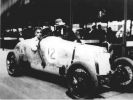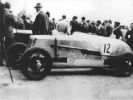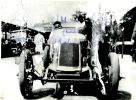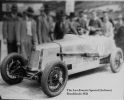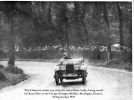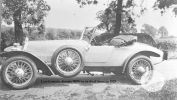
The first purpose built racing car by Lea-Francis
| Engine | Anzani or Meadows |
| Wheelbase: | 8' 9" |
| Track | 3' 9" |
The first purpose built racing car by Lea-Francis, was called the Lea-Francis Special and on occasions, this name was initially painted on the side of the tail. However, it soon acquired the nickname Lobster because of the long sloping tail, not, as is sometimes assumed, because of its colour. When it first appeared at Brooklands, for the August Bank Holiday meeting in 1926, it was finished in polished aluminium.
The Lobster saw the first use of a 15 degree sloping radiator by Lea-Francis. The radiator was fitted to an elegantly dropped cross-member, had sloping sides and although similar in appearance to that later fitted to the the S Type (or Hyper) models was significantly smaller. The radiator filler cap was hidden under the bonnet, on the header-tank, so as not to detract from the smooth lines of the bodywork, which had been created by Cross & Ellis. It was effectively an offset single-seater, with the driver’s seat mounted on the right hand side and a cowl covering what would be the passenger’s side of the car. The bonnet was louvered only on the off-side with the exhaust exiting the nearside and then running the length of the car, the mandatory Brooklands silencer mounted about half way down the car and the system terminating in a fish-tail. A petrol tank of 16 gallons capacity was fitted in the tail and pressurised by a hand pump mounted in the centre of the dashboard. The gearbox was fitted with a centre change, which was unusual on Lea-Francis cars. This arrangement was almost certainly due to the narrowness of the bodywork and the reluctance to have the gear lever on the outside of the car and thereby disrupting the lines of the body – see the comment above about the radiator cap. The front axle followed general Lea-Francis practice of the time and was mounted on semi-elliptic springs. However, the springs were flatter than those fitted to the road cars and the front axle was dropped i.e. with a steeper than standard angle from spring pads to hub centres. These features served to lower the car significantly. While actually quite different from a standard chassis, for example the dropped cross-member carrying the radiator, the car frame was given chassis number 9030 from the L Type series.
For all but one event in 1926 the car ran with an unblown Meadows 4ED engine fitted with twin Solex carburettors and was driven to good effect in a number of events. However, for the 200 mile race at Brooklands on 25 September 1926, the Lobster ran supercharged, but not in a form one might expect of Lea-Francis. It was fitted with an Anzani side-valve engine blown by a Berk supercharger. The race was a failure for Lea-Francis as the car retired well before half distance with a seized supercharger. For the rest of 1926 the car ran in competition with an unblown Meadows 4ED, although it was used by the Works as a test bed for a variety of other superchargers. In late 1926 or early 1927 the Lobster was experimentally fitted with a standard single port 4ED engine blown by a Cozette supercharger and breathing through a Cozette carburettor – a precursor to the arrangement eventually adopted for the S Type. This experiment was extremely short lived and terminated itself when the engine let go after the first half mile. However, it had demonstrated the effectiveness of this combination and subsequent modification, including a reduction in the compression ratio, resulted in a powerful and reliable engine and Lea-Francis announced their intention to bring to market a supercharged road car. The S Type was still at a testing stage, so to publicise the new model but without revealing the all-new chassis design, the Lobster, and another chassis (number 9098), were fitted with fabric covered two-seater bodies with pointed tails, a supercharged Meadows 4ED engine and road equipment. The two cars were registered for road use by Lea-Francis in August 1927 (9030 as WK 3329, 9098 as WK 1270) and road-tested by a number of motoring publications.
Sadly, neither car has survived. 9030, the original Lobster, was scrapped in 1936 and its sister car, 9098 believed to have been scrapped in 1948.

